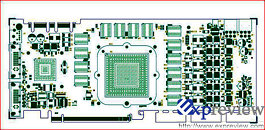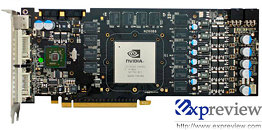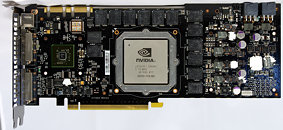- Joined
- Oct 9, 2007
- Messages
- 47,904 (7.37/day)
- Location
- Dublin, Ireland
| System Name | RBMK-1000 |
|---|---|
| Processor | AMD Ryzen 7 5700G |
| Motherboard | Gigabyte B550 AORUS Elite V2 |
| Cooling | DeepCool Gammax L240 V2 |
| Memory | 2x 16GB DDR4-3200 |
| Video Card(s) | Galax RTX 4070 Ti EX |
| Storage | Samsung 990 1TB |
| Display(s) | BenQ 1440p 60 Hz 27-inch |
| Case | Corsair Carbide 100R |
| Audio Device(s) | ASUS SupremeFX S1220A |
| Power Supply | Cooler Master MWE Gold 650W |
| Mouse | ASUS ROG Strix Impact |
| Keyboard | Gamdias Hermes E2 |
| Software | Windows 11 Pro |
The introduction of the new G200b series graphics processors sought to revive NVIDIA's stronghold over the high-end graphics market, by reducing manufacturing costs, and facilitating high-end graphics cards at unusually low price-points, to compete with rival ATI. The first SKU using the G200b GPU was the new GeForce GTX 260. The PCB of design of the new model (P654) saw several drastic changes, that also ended up contributing to the cost-cutting: all memory chips were placed in the business end of the PCB, and the VRM area rearranged. News emerging from Expreview suggests that NVIDIA has worked out an even newer PCB reference design (model: P897) that aims mainly to cut production costs further. The reference design graphics board based on the PCB will be given the internal name "D10U-20". A short list of changes is as follows:
The new PCB is expected to reduce costs by as much as US $15 which will impact on the overall product cost, and help step up the competitiveness. Expreview notes that the new PCB will be available to the partners by the third week of this month. Below are the drawing and picture of the PCB. For reference, the second picture is that of the older P654 design.



View at TechPowerUp Main Site
- The number of PCB layers has been reduced from 10 to 8, perhaps to compress or remove blank, redundant or rudimentary connections
- A 4+2 phase NVVDD power design using the ADP4100 voltage regulator IC, the FBVDDQ circuit has been reduced from 2 phases to 1, and the MOSFET package has been changed from LFPAK to DPAK grouping, to reduce costs. The ADP4100 lacks the I2C interface, which means voltage control will be much more difficult than on current PCBs of the GeForce 260,280, 285 and 295
- The optional G200b support-brace has been removed
- While the length of the PCB remains the same, the height has been reduced to cut costs
- BIOS EEPROM capacity reduced from 1 Mbit (128 KB) to 512 Kb (64 KB)
- Cheaper DVI connectors
The new PCB is expected to reduce costs by as much as US $15 which will impact on the overall product cost, and help step up the competitiveness. Expreview notes that the new PCB will be available to the partners by the third week of this month. Below are the drawing and picture of the PCB. For reference, the second picture is that of the older P654 design.



View at TechPowerUp Main Site
Last edited:

 ", lol.
", lol.




